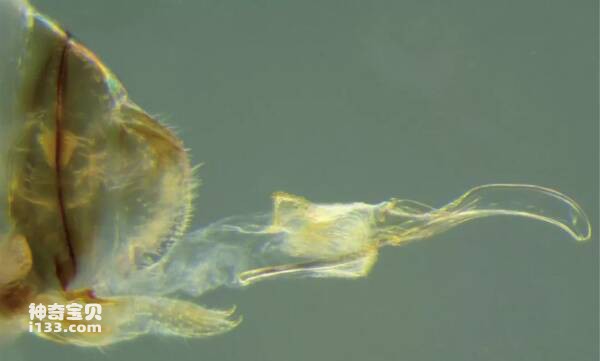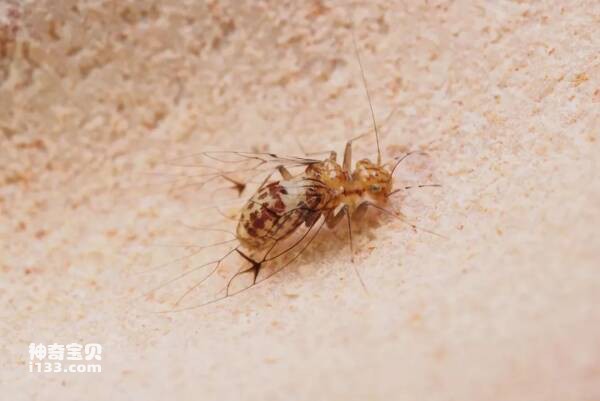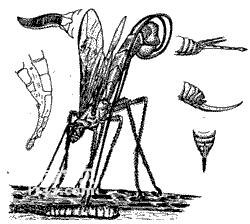The eighth and ninth segments of the female adult have structures for laying eggs, called ovipositors. The ovipositor is generally tubular and consists of the first ovipositing valve located on the eighth abdominal segment and the second and third ovipositing valves located on the ninth abdominal segment. The third ovipositing valve is the back of the ovipositor ( Dorsal egg-laying valve), the first egg-laying valve is ventral (ventral egg-laying valve), and the second egg-laying valve is in the middle (endo-ovulation valve).

The ovipositors of insects have various shapes. The ovipositor of crickets is spear-shaped; the ovipositor of katydids is like a large knife; the ovipositor of sawflies is like a toothed saw; the ovipositor of some bees is like a saw. The egg apparatus is a slender pincer, some of which is short. It is specialized into a pincer that can inject venom. It is usually hidden in the body. When catching prey, it extends the pincer host or to defend against enemies. The eggs are laid from the base of the pincer. Such as wasps, bees, etc.; the ovipositor of the wasp is usually very long, even several times longer than the body length, and can easily lay eggs on the surface or body of the host. Not all insects have ovipositors, such as beetles, butterflies, moths, flies, etc. The eggs are laid at the end of the abdomen. The segments at the end of their abdomen gradually become slender and overlap each other, and they can stretch when laying eggs. They are very long and lay their eggs in crevices, surfaces or depressions. This structure is called a pseudoovipositor. Some lower species in the subclass Pterozoa, such as mayflies, do not have specialized ovipositors. Eggs are produced through a pair of ovipositing holes formed by two lateral oviducts on the membrane behind the seventh abdominal plate. . The shape, structure and presence of ovipositors can help us understand the methods and habits of insects laying eggs. For example, locusts with cone-shaped ovipositors and crickets with spear-shaped ovipositors lay eggs in the soil and have no special characteristics. Insects with modified ovipositors can only lay eggs on surfaces or shallow crevices. Cicadas, leafhoppers, etc. have needle-shaped ovipositors. Like sawflies and hornets with saw-like ovipositors, they always lay their eggs in plant tissues, while parasitic wasps often use exposed needle-shaped ovipositors. The egg organ is used to lay eggs in or on the body of the host.

The external genitalia of male insects is called the copulatory organ, which is a structure used for mating. The copulator mainly consists of two parts: the penis and the holder. The penis delivers sperm into the female's body, and the clasp is responsible for holding the female's body in a suitable position during mating. The penis is generally a cone-shaped or tube structure, including the base of the penis and the penis, with the end of the penis being the opening of the ejaculatory duct. During mating, under the pressure of muscle activity and blood, the penis extends out of the body until it is deeply inserted into the female's mating sac and the sperm is transferred into the mating sac. The grippers are mostly derived from the appendages of the ninth abdominal segment, and their shapes vary greatly. Both the penis and the gripper show different changes in different taxa. For example, insects of the order Orthoptera, Blattida, and Mantids have only the penis and its derivative structures as their male external genitalia, without a gripper, while the insects of the order Homoptera except In addition to a well-developed penis, there are also auxiliary mating devices, including a gripper. The morphology of the external genitalia of different species of insects varies greatly to achieve interspecific isolation and ensure that only individuals of the same species can mate. Therefore, the structure of male external genitalia is very important in insect classification, especially in the identification of closely related species, which are almost indistinguishable without male external genitalia.

animal tags: genitals insect copulator ovipositor reproduction
We created this article in conjunction with AI technology, then made sure it was fact-checked and edited by a Animals Top editor.